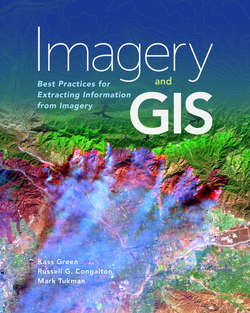Читать книгу Imagery and GIS - Kass Green - Страница 51
На сайте Литреса книга снята с продажи.
Spatial Resolution
ОглавлениеAn image’s spatial resolution is determined by the altitude of the platform, and the viewing angle, lens focal length, and resolving power of the sensor. Spatial resolution has two different definitions:
The smallest spatial element on the ground that is discernible on the image captured by the remote sensing system. The definition of “discernible” can refer to the ability to detect an element as separate from another, or to both detect and label the different elements. This definition was commonly used when remotely sensed images were collected primarily on film.
The smallest spatial unit on the ground that the sensor is able to image. This is the more common meaning and is the one relied upon by makers and users of digital remote sensing systems. Usually, it is expressed as the ground sample distance (GSD), which is the length on the ground of one side of a pixel.
GSD is a function of sensor pixel size, height above terrain, and focal length, as expressed in the following equation:
The distance to ground is a function of platform altitude and sensor viewing angle. If focal length and sensor resolving power are held constant (as they are in most airborne systems), then the lower the altitude of the system, the smaller the GSD and the higher the spatial resolution of the resulting imagery. If focal length and distance to ground are held constant (as they are in satellite systems), then the higher the sensor resolving power, the higher the spatial resolution. If sensor resolving power and distance to ground are held constant, then the longer the focal length, the higher the spatial resolution of the sensor. Because the sensor and the altitude of satellite remote sensing systems are constant over the usable life of the system, their spatial resolutions are also fairly constant for each satellite system and change only when the viewing angle is changed.
Airborne systems have varying spatial resolutions depending on the sensor flown and the altitude of the aircraft platform. Spatial resolution is also affected by whether the sensor has a stabilized mount, a forward motion compensation unit, or both, which compensate for the forward motion of the aircraft and minimize the blur caused by the motion of the platform relative to the ground by moving the sensor in the reverse direction of that of the platform (and at the ground speed of the platform) during sensor exposure. Figure 3.17 compares the spatial resolution of 15-meter pan-sharpened Landsat imagery to that of airborne 1-meter National Agriculture Imagery Program (NAIP) imagery over a portion of Sonoma County, California. Figure 3.18 compares the NAIP imagery to 6-inch multispectral imagery over a subset of the same area.
Figure 3.17. Comparison of Landsat 15-meter pan-sharpened satellite imagery to 1-meter National Agriculture Imagery Program (NAIP) airborne imagery over a portion of Sonoma County, California. Color differences are due to sensor differences and the imagery being collected in different seasons. (esriurl.com/IG317)
Figure 3.18. Comparison of 1-meter National Agriculture Imagery Program (NAIP) imagery to 6-inch airborne imagery over a subset of the area of figure 3.17. Color and shadow differences are due to sensor differences and the imagery being collected in different seasons. (esriurl.com/IG318)
The highest spatial resolution obtainable from a civilian satellite is WorldView-4’s 30 centimeters (11.8 inches). High-resolution airborne multispectral sensors have spatial resolutions of 2 to 3 centimeters at an altitude of 500 feet (e.g., UltracamEagle). Because they can fly lower than piloted aircraft, UASs can obtain higher spatial resolutions than manned aircraft.
